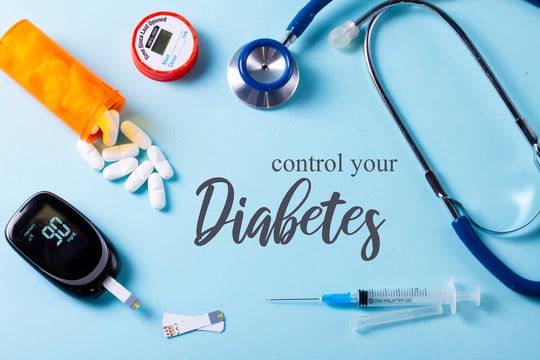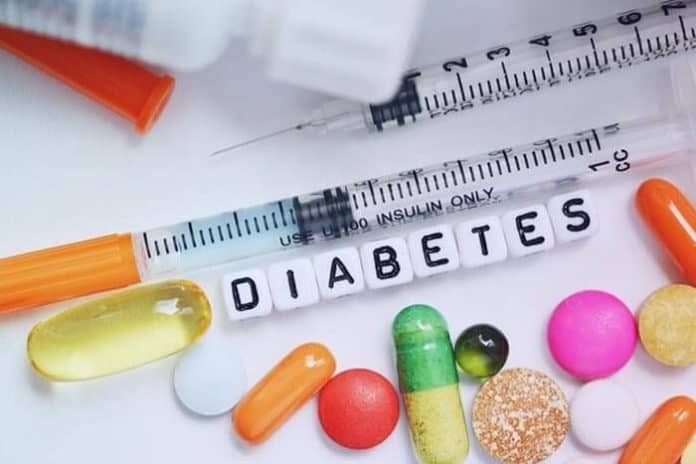Diabetes is a major issue in the US, yet some people don’t know what it is. We need to take action in our lives to reduce the risk. Here are some key facts about diabetes.
Simply put, diabetes mellitus, commonly known as diabetes, refers to a health condition that causes high blood sugar (glucose). Where the body has difficulty converting sugar to energy.
Diabetes occurs when your body doesn’t use insulin properly or doesn’t make enough insulin. It has everything to do with how your body manufactures or processes insulin. Insulin is a hormone that helps your body’s cells use glucose for energy. It is the “key” that allows glucose to enter the cells from the blood.
If the body doesn’t produce enough insulin to effectively manage glucose, it can’t function or perform properly. With diabetes, your body either doesn’t make enough insulin or can’t effectively use its insulin.
What are the Types of Diabetes?
Type 1 Diabetes:
Type 1 diabetes (T1DM) is a chronic health condition. People with type 1 diabetes are a condition in which the pancreas produces little to no insulin. This is because your immune system has destroyed all the insulin-producing cells in your pancreas.
This disease is more commonly diagnosed in young people, although it can develop in adulthood.
It’s also worth noting that the damage to the pancreas can even be the result of a type of virus called enteroviruses, such as congenital rubella syndrome.
Type 2 Diabetes:
The pancreas can initially produce insulin for people with type 2 diabetes, but your body’s cells can’t respond to it effectively. This is known as insulin resistance.
What is insulin resistance?
Insulin resistance, in which your cells stop responding to insulin, is incredibly common. It also increases your risk of progressing to diabetes. They can’t easily take glucose from your blood. And this condition typically doesn’t trigger any noticeable symptoms.
As a result, your pancreas makes more and more insulin to help glucose enter your cells. Over time, these overworked pancreas cells wear out and just can’t keep up with the demand.
New research indicates that insulin resistance in type 2 diabetes is the result of B cells (the cells that work by producing antibodies to fight antigens or “invaders”) and other immune cells attacking your body’s tissue.
Type 3 Diabetes: Alzheimer’s
This condition also has been used by some to describe people who have type 2 diabetes and are also diagnosed with Alzheimer’s disease dementia. Which is triggered by a type of insulin resistance and insulin-like growth factor dysfunction that occurs specifically in the brain.
Alzheimer’s is a neurodegenerative disease that affects memory and thinking skills. These changes interfere with daily living. And it seems that brain insulin resistance and inflammation are significant markers of developing Alzheimer’s disease. This is due to a process called glycation, which is caused by elevated blood sugar that is not metabolized by insulin.
Prediabetes
Prediabetes is elevated blood sugar that is not yet high enough to be considered type 2 diabetes. Prediabetes, characterized by a fasting glucose level between 100 and 125 mg/dL, is becoming more common across America.
According to the National Institutes of Health (NIH), prediabetes is reversible. The first step in managing prediabetes is understanding what a prediabetes diagnosis means. Treatment may include lifestyle modifications, such as diet and exercise, and medication.
Prediabetes, considered the beginning of the diabetes spectrum, is a warning sign that you need to act now to preserve your health. And if you receive a prediabetes diagnosis, it means you have a higher-than-normal blood sugar level.
Gestational Diabetes
Gestational diabetes is the most common medical issue affecting pregnant women. It is usually diagnosed between weeks 24 and 28 by an OB/GYN. It occurs when a pregnant woman has blood sugar levels that are too high. Preventing a pregnant woman from balancing the high blood sugars common in pregnancy. In this condition, it is dangerous for the baby to be born too early, have problems with breathing, weigh too much, and have low blood glucose levels after birth.
Pregnant women, are also at risk for preeclampsia — a dangerous condition that involves the abnormal development of the placenta, high blood pressure during pregnancy, and high levels of protein in your urine.

Warning Signs and Symptoms of Types 1, 2, and 3 Diabetes
Type 1 Diabetes Symptoms
- extreme hunger
- increased thirst
- dramatic weight loss in a short period
- fatigue
- frequent urination
- blurry vision
- tiredness
It may also result in mood changes.
A person might also develop ketoacidosis, a complication of diabetes. Symptoms of this condition include:
- vomiting or stomach pain
- fruity breath odor
- rapid breathing
- flushed face
- dry skin and mouth
- nausea
If you have one or more type 1 diabetes symptoms, you should visit your doctor. But if you have symptoms of ketoacidosis, you should get medical help right away. Ketoacidosis is a medical emergency.
Type 2 Diabetes Symptoms
- constant hunger
- weight loss
- extreme thirst
- frequent urination
- dry mouth
- blurry vision
- fatigue
- a lack of energy
- itchy skin
As the disease progresses, the symptoms become more severe and potentially dangerous. If your blood glucose levels have been high for a long time, the symptoms can include:
- yeast infections
- slow-healing cuts or sores
- dark patches on your skin, a condition known as acanthosis nigricans
- foot pain
- feelings of numbness in your extremities, or neuropathy
If you have two or more of these symptoms, you should see your doctor. Without treatment, diabetes can become life-threatening.
Type 3 Diabetes Symptoms
The symptoms of type 3 diabetes are described as the symptoms of dementia, such as those seen in early Alzheimer’s disease.
According to the Alzheimer’s Association, these symptoms include:
- memory loss that affects daily living and social interactions
- difficulty planning and/or problem-solving
- misplacing things often
- confusion about dates, names, and/or places
- forgetting common words or losing the train of thought in the middle of a sentence
- decreased ability to make judgments based on information
- sudden changes in personality or demeanor
- withdrawal from social activities
While many of these changes can come with normal aging or other health problems, including drug or alcohol abuse, a blood screening is in order if these symptoms persist.
What are the causes of Diabetes?
Type 1 and type 2 diabetes may have similar names, but different causes are associated with each type of diabetes.
Causes of Type 1 Diabetes
The exact cause of type 1 diabetes is unknown. For some reason, the immune system mistakenly attacks and destroys insulin-producing beta cells in the pancreas. After these beta cells are destroyed, the body is unable to produce insulin. These are the cells that make insulin. Scientists don’t fully understand why this happens.
Causes of Type 2 Diabetes
People with type 2 diabetes have insulin resistance. The body still produces insulin, but it’s unable to use it effectively. Over time, this can damage cells in your pancreas. This leaves your body’s cells starved for energy. If you don’t produce enough insulin or if your body doesn’t use it efficiently, glucose builds up in your bloodstream.
Researchers aren’t sure why some people become insulin resistant and others don’t, but several lifestyle factors may contribute, including being inactive and carrying excess weight. Carrying extra weight, especially in your belly, makes your cells more resistant to the effects of insulin on your blood sugar. In some people, the liver produces too much glucose. There may be a genetic predisposition to developing type 2 diabetes. There could also be an environmental trigger. Most likely, it’s a combination of factors that increases the risk of type 2 diabetes.

The Risk Factors of Diabetes
Certain factors increase your risk for diabetes.
Risk factors for type 1 diabetes include:
Family history
If you have a parent or sibling with type 1 diabetes, you are likely to have a higher risk of developing type 1 diabetes.
Age
Type 1 diabetes can appear at any age, but it’s most common among children and adolescents.
Genetics
Several genes have been linked to this condition. The presence of certain genes points to an increased risk of developing type 1 diabetes. However, not everyone who has these genes develops type 1 diabetes.
Race
Race may be a risk factor for type 1 diabetes. It’s more common in white people than in people of other races.
Geography
The prevalence of type 1 diabetes increases the farther away you are from the equator.
Environmental factors
Some viruses may trigger type 1 diabetes. However, it’s unclear which ones might be the culprits.
Risk factors for type 1 diabetes are poorly understood. However, some potential factors have been identified.
Risk factors for type 2 diabetes:
Your risk of developing type 2 diabetes if you:
- are carrying excess weight or have obesity
- have a parent or sibling with the condition
- aren’t physically active
- are age 45 or older
- have ever had gestational diabetes, which is diabetes during pregnancy
- have high blood pressure, high cholesterol, or high triglycerides
- have African American, Hispanic or Latino American, Alaska Native, Pacific Islander, American Indian, or Asian American ancestry
- have polycystic ovary syndrome (PCOS)
The most common risk factors for gestational diabetes include:
High BMI
Research shows that a higher BMI before pregnancy and a higher BMI at 28 weeks of pregnancy are strongly related to increased insulin resistance. A BMI of 30 or higher can increase your risk of developing gestational diabetes.
Age
If a pregnant woman is over the age of 25, she is at a greater risk of developing gestational diabetes.
History of Diabetes
Women who have already had gestational diabetes, or those with prediabetes symptoms before pregnancy, are at a greater risk of developing gestational diabetes again. If you have a family history of diabetes, such as a parent or sibling having Type 2 diabetes, you are also at an increased risk of gestational diabetes.
Polycystic Ovary Syndrome
A nationwide population-based survey published in PLoS ONE indicates that a history of the polycystic ovarian syndrome (PCOS) is a significant and independent risk factor for the development of gestational diabetes. About 50 percent of women with PCOS experience metabolic disturbances, which is why they are often monitored closely during pregnancy to ensure that they follow a strict diet and don’t gain too much weight.
How to Diabetes Treated
There’s no cure for type 1 diabetes. People with type 1 diabetes don’t produce insulin, so some of these drugs are taken by mouth, while others are available as injections. Also, blood sugar testing is an essential part of managing type 1 diabetes, because levels can go up and down quickly.
Four types of insulin are most commonly used. They’re differentiated by how quickly they start to work, and how long their effects last:
- Rapid-acting insulin starts to work within 15 minutes and its effects last for 3 to 4 hours.
- Short-acting insulin starts to work within 30 minutes and lasts 6 to 8 hours.
- Intermediate-acting insulin starts to work within 1 to 2 hours and lasts 12 to 18 hours.
- Long-acting insulin starts to work a few hours after injection and lasts 24 hours or longer.
You can effectively manage type 2 diabetes. Type 2 diabetes can be managed and even reversed with diet and exercise alone, but many people need extra support.
Follow these tips to manage type 2 diabetes:
- Include foods rich in fiber and healthy carbohydrates in your diet. Eating fruits, vegetables, and whole grains will help keep your blood glucose levels steady.
- Eat at regular intervals
- Only eat until you’re full.
- Control your weight and keep your heart healthy. That means keeping refined carbohydrates, sweets, and animal fats to a minimum.
- Get about half an hour of aerobic activity daily to help keep your heart healthy. Exercise helps to control blood glucose, too.
Your doctor will explain how to recognize the early symptoms of blood sugar that are too high or too low and what to do in each situation. He/She may recommend testing your blood sugar occasionally or more frequently. If your blood sugar levels are high, your doctor may recommend insulin injections.
There are separate treatment options for people who have:
- pre-type 2 diabetes
- type 2 diabetes
- Alzheimer’s
Lifestyle changes, such as making changes to your diet and including exercise in your daily routine, maybe a big part of your treatment.
You’ll need to monitor your blood sugar level several times a day during pregnancy. Along with dietary changes and increased physical activity, the following medications or forms of therapy may be utilized:
Insulin Therapy
Insulin injections may be needed to lower your blood sugar levels. Insulin therapy is utilized when dietary and lifestyle changes alone do not maintain glycemic control during pregnancy. Insulin is also safe for the growing baby.
Glyburide
Glyburide is a prescription drug. It is an oral antidiabetic agent that is often used as a first-line agent for gestational diabetes or as an alternative to insulin therapy.
Metformin
Metformin is another oral anti-diabetic drug that’s used to fight gestational diabetes. According to researchers, there is now a reasonable amount of data to support that both metformin and glyburide can be useful for women with gestational diabetes. The safety and efficacy of these drugs, compared to insulin therapy, are still being researched.

Natural Ways to Lower Blood Sugar Levels
High blood sugar occurs when your body doesn’t make enough or effectively use insulin, such as allowing your cells to take in sugar from your blood for energy.
Here is a list of natural ways to lower your blood sugar levels.
- Regular Exercise
Engaging in regular physical activity can be a fast and effective way to lower your blood sugar levels. It can help you get to and maintain a moderate weight and makes your body more sensitive to insulin.
- Drink Plenty of Water
Drink plenty of water. It will help you keep your blood sugar levels within healthy limits.
If your urine is yellow, you’re likely dehydrated. When you are dehydrated, your kidneys are retaining the fluid to stop the body from flushing out excess sugar in your urine. To prevent dehydration, drinking plenty of water will helps your kidneys flush out the excess sugar through urine.
- Get Enough Sleep
Getting enough sleep can help reduce stress, balance blood sugar levels, and is necessary for good health.
Both too little and too much sleep affect blood sugar levels and insulin sensitivity. They can increase appetite and promote weight gain.
With sleep, quality is as important as quantity. It’s best to get a sufficient amount of high-quality sleep every night.
- Reduce Stress
Stress can affect your blood sugar levels. It can negatively affect your health in some ways, causing headaches, increased blood pressure, and anxiety.
As stress levels go up, your body releases certain hormones. These hormones are glucagon and cortisol which cause blood sugar levels to go up.
Try out these relaxation methods to reduce stress and help correct insulin secretion problems in chronic diabetes. These might include:
- meditation
- journaling
- listening to music
- taking a short walk
- any other activity you especially enjoy
5. Follow a Low-Carb Diet
Carbohydrates (carbs) are what cause blood sugar and insulin levels to rise.
When you eat carbs or have insulin-function problems, this process fails, and blood glucose levels can rise. For this and other reasons, low-carb diets can be very effective for aiding weight loss and controlling diabetes.
Many studies have confirmed that consuming a low-carb diet can help prevent blood sugar spikes. Because of their ability to lower insulin levels and increase insulin sensitivity, compared to other diets.
Aside from the above-mentioned, some herbs and spices can lower blood sugar levels.
- Cinnamon
Cinnamon is an aromatic spice obtained from the inner bark of several species of Cinnamomum trees. It is used in both sweet and savory foods.
Cinnamon is used in traditional medicine because it is high in nutrients, cleansing properties, and healing attributes, cinnamon is certainly a spice to be treasured.
Cinnamon can control blood sugar, it is known to regulate blood sugar and insulin levels and monitor its function. It improves insulin sensitivity. Cinnamon is also extremely effective at lowering insulin resistance. Moreover cinnamon works on muscle cells to remove glucose molecules from the bloodstream thus reducing blood sugar levels.
- Bitter Melon
Bitter melon (also known as Momordica charantia or bitter gourd) is a member of the family Cucurbitaceae, one of the most beneficial fruits in the tropical and subtropical regions of Africa, Asia, South America, and the Caribbean. Its potent medicinal properties have been valued and used for centuries.
When it comes to fighting diabetes, this unusual melon contains three main components that have been shown to have glucose-lowering properties such as polypeptide-p, charantin, and vicine.
Thanks to its potent medicinal properties, bitter melon is linked to lowering the body’s blood sugar. This is because the bitter melon has properties that act like insulin, to help treat diabetes-related conditions.
- Mulberry Leaf
Mulberry trees produce flavorful berries in various regions across the world. The berries themselves look a bit like a thinner blackberry and are often deemed superfoods due to their concentration of vitamins, minerals, and powerful plant compounds.
Mulberry leaf extract has been used in traditional Chinese medicine for various issues, they’re loaded with powerful plant compounds like polyphenol antioxidants, as well as vitamin C, zinc, calcium, iron, potassium, phosphorus, and magnesium.
One of the most effective and potent natural blood sugar regulators is the mulberry leaf. These attributes may make them useful for fighting heart disease and diabetes. In particular, these leaves may reduce high levels of blood sugar and insulin, a hormone that regulates blood sugar levels.
- Juniper Berry
The juniper tree, Juniperus communis, is a type of conifer (Pinophyta), which is a cone-bearing plant or tree that grows in many parts of the world.
These small berries have been used for culinary and medicinal purposes since ancient times, and current research suggests that they may offer various health benefits.
Juniper berries were used in traditional medicine practices to treat diabetes, and ethanol extract and tea of juniper berries seem to have the potential to reduce high blood sugar in diabetic rats. Though these findings are promising, research on humans is needed to confirm this potential health benefit.
- Licorice Root
Licorice root may just be one of the most overlooked herbs when it comes to healing. It has been long used to treat various ailments and flavor candies, drinks, and medicines.
In a study in rats, daily intake of licorice root extract resulted in significant improvements in blood sugar levels and kidney health. This effect has not been confirmed in humans.
- Guggul
Guggul is an ancient remedy that has been used in Ayurvedic medicine, a holistic, plant-derived medical system, to treat various health conditions, such as arthritis, obesity, thyroid imbalance, inflammation, and urinary tract infections.
Guggul’s purported to have the ability to lower blood sugar and manage diabetes. However, recent evidence is lacking, and much of the research on guggul and its effect on blood sugar levels was conducted in animals. More research is needed to determine what are the effects, if any, on blood sugar control in humans.



